Rudraksha

Rudraksha (IAST:Rudrākṣa, Devanagari: रुद्राक्ष, Bengali: রুদ্রাক্ষ, Kannada:ರುದ್ರಾಕ್ಷಿ,[1] Telugu: రుద్రాక్ష,[2] Tamil:ருத்ராட்சம்[3]) is a seed traditionally used as prayer beads in Hinduism (especially Shaivism). Rudraksha bead are covered by an outer shell of blue color on fully ripening, hence also called blueberry beads.[4] The seed is produced by several species of large evergreen broad-leaved tree in the genus Elaeocarpus, with Elaeocarpus ganitrus roxb being the principal specie.[5] They are associated with the Hindu deity Lord Shiva and are commonly worn for protection and chanting Om Namah Shivaya mantra by devotees. The seeds are primarily used in India and Nepal as beads for organic jewellery and malas and are valued similarly to semi-precious stones. Various meanings and potencies are attributed to beads with different numbers of segments (faces/mukh) and rare or unique beads are highly prized and valuable.
Etymology
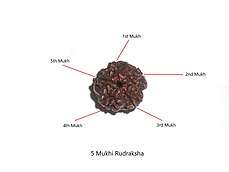
Rudraksha is a Sanskrit compound word consisting of the Rudra (Sanskrit: रुद्र) and akṣa (Sanskrit: अक्ष ).[6][7] Rudra is one of Lord Shiva's vedic names and Akṣa means 'teardrops'. So it means Lord Rudra's (Lord Shiva's) teardrops.
There are other sources like Satguru Sivaya Subramuniyaswami and Kamal Narayan Seetha who describes Akṣa as eye. So meaning of Rudraksha could also constitutes as "Eye of Lord Shiva" or "Eye of Rudra". [8][9][10]
Significance and Spiritual Use
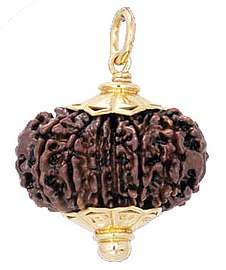

Rudraksha term is used both for the berries themselves and as a term for the type of mala made from them.[11] There is a long tradition of wearing Rudraksha beads[12] in India, particularly among Shaivism, due to their association with Lord Shiva. Lord Shiva himself wears rudraksha garlands. Om Namah Shivaya mantra is repeated (japa) using the rudraksha beads.[13] Rudraksha malas have been used by Hindus as rosaries from at least the 10th century [14] for meditation purposes and to sanctify the mind, body and soul.
Rudraksha beads may be strung together as a mala and used to count the repetition of a mantra or prayer, similar to the use of rosaries in Christianity. Most garlands contain 108 beads plus one, as 108 is considered sacred and a suitable number of times to recite a short mantra. The extra bead, called the "Meru", bindu or "guru bead", helps mark the beginning and end of a cycle of 108, as well as having symbolic value as a 'principle' bead. While counting the mala the meru should not be overtaken but when meru is reached then mala is recited in reverse order. Recitation should be done after covering the mala and it should not touch the ground. After recitation mala should be kept in cotton bag. Rudraksha mala's usually contain beads in following combination: 27+1, 54+1 or 108+1. 54+1 needs to be recited twice for one complete round. 27+1 needs to be recited four times for one complete round. It is possible to carry a single seed or several seeds strung on the same thread. Devi-Bhagavata Purana describes preparation of rudraksha mala.[15] Rudraksha till 14 mukhi found reference in Shiva Purana, Padma Purana, Devi-Bhagavata Purana, Skanda Purana etc.[16] The beads are commonly strung in silk or in a black or red cotton thread. Less often, jewellers may use copper, silver or gold wires[17][18] though the rudraksha may be damaged if strung too tightly.
Description of the tree
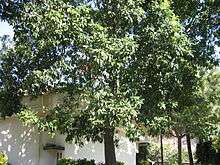
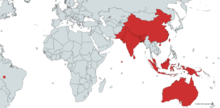
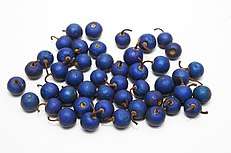
Elaeocarpus ganitrus roxb grows 60-80 feet and are found from the Gangetic plain in the foothills of the Himalayas to Southeast Asia, India, Nepal, Indonesia, New Guinea to Australia, Guam,Hawaii,[19] China, Taiwan, parts of Malaysia and Java(Indonesia). Out of 300 species of Elaeocarpus 35 are found in India.[20]
Rudraksha seeds are covered by an outer husk of blue when fully ripe, and for this reason are also known as blueberry beads. The blue color is not derived from pigment but is structural.[21] It is an evergreen tree that grows quickly. The Rudraksha tree starts bearing fruit in three to four years from germination. As the tree matures, the roots form buttresses, rising up near the trunk and radiating out along the surface of the ground.
General information on the Rudraksha tree: found from sea level up to 3000m above. The Rudraksha tree grows in a narrow space, not on open ground. Its leaves resemble those of tamarind or nux vomica, but are longer. It yields one to two thousand fruits annually. These fruits are also known as Amritphala (Fruits of Nectar).[22]
Type of Rudraksha beads
Rudraksha bead are found in from 1 to 21 mukhi. Recently 27 mukhi rudraksha was found in Nepal. 80% of all rudraksha are 4, 5 (most common) and 6 mukhi. 1 mukhi is rarest bead. Rudraksha from Nepal are of bigger size (25-30 mm) and Indonesian rudraksha are smaller in size(4-12 mm). Rudraksha are available in white, red, brown (most common), yellow and black color.
There are special type of rudraksha available like Gauri Shankar (two Rudraksha are naturally joined), Ganesha (a Rudraksha having trunk like protrusion on its body), Sawar (a Gauri Shankar in which one bead has only one line or Mukh), Trijuti (three Rudraksha-beads joined naturally) and the rare ones like Ved (4 Sawars on a bead) ,Dwaita (Two sawars on the bead etc).[23]
Surface texture of Rudraksha bead
A Rudraksha's surface should be hard and the projections should be well grooved, as found in most of the Nepalese Rudrakshas. Indonesian Rudraksha has a different appearance. Rudraksha from India shows very high and deeply grooved projections resembling natural deep hills and valleys.
Fake Rudraksha


Most faked rudraksha are 1 mukhi due to its rarity. A variety of rudraksha called 1 mukhi half-moon is thus sold in its place which is genuine and more easily available version of 1 mukhi rudraksha. 1 mukhi is faked using berries and Areca nut. Also some suppliers sell fake rudraksha which have Serpent, Trishul, Shiva-lingam etc carved on them. A real rudraksha does not have these markings. Fake rudraksha are also made by carving extra lines on lower mukhi rudraksha to obtain the rare and higher priced higher-mukhi rudraksha or by hiding lines to make a rarer lower mukhi rudraksha. Also fake Gauri Shankar rudraksha is made by gluing together two rudraksha beads.
To recognize real rudraksha many technique are used like sinking and floating of rudraksha as well as revolving rudraksha in between two copper coins. But these are not correct criteria. Some techniques which helps:-
- Use magnifying glass and examine for artificially carved lines which are generally very sharp and glued surfaces on the bead.
- Whenever checking genuinity of a joint or of a line on rudraksha for example checking a Gauri shankar for joints or lines in higher mukhi then make sure to boil rudraksha in water for 1 to 2 hours. Sharp discoloration will take place at the joint or at the artificially created line.
- Cut the bead horizontally. There are same number of compartments as that of the number of lines on rudraksha.
- Best of all is doing x-ray of the rudraksha.[24]
Composition
Composition of Rudraksha
Rudraksha beads contain carbon, nitrogen, hydrogen, oxygen and trace elements in combined form. The Rudraksha fruit have many phytoconstituents such as alkaloids, Flavonoid, Tannin, steroids, Triterpene, carbohydrates and cardiac Glycoside. It contain Rudrakine, a new found alkaloid[25]
Uses of Rudraksha
Rudraksha exhibit multifarious pharmacological activities that include Anti-inflammatory, analgesic, sedative, antidepressant, Anti-asthmatic, Hypoglycemia, Antihypertensive, smooth muscle relaxant, hydrocholeretic, antiulcerogenic and anticonvulsant.[26][27]
In Ayurveda the bead, bark and leaves of Rudraksha are used for curing various ailments like mental disorders, headache, fever, skin diseases etc. It is used for curing cough, breathing problems, controlling epilepsy, liver related problems, jaundice, stomachache, high blood pressure, improving memory power, controlling brain fever, doing blood purification, having antibacterial effect and is used on burns. Rudraksha fruits are thermogenic, sedative, is useful in cough, bronchitis, neuralgia, cephalagia, Anorexia, migraine, manic conditions and other brain disorders. The flesh or pulp of drupe is given in epilepsy, diseases of head and in mental illness.[28]
Electric Properties of Rudraksha
Rudraksha has electric, electromagnetism, paramagnetic and inductive properties which varies for different mukhi rudraksha. It was remarkable that seeds of same tree behave differently because of natural division. It was also discovered that rudraksha's electromagnetic power of 7 milli-volt is equal to human body.[29] Rudraksha beads controls and normalizes the flow of bioelectric current in body. Rudraksha exhibits the following electric properties:
Confrontation
It is main electric properties of the Rudraksha which is maintaining the bioelectric properties of body and their parts. Rudraksha of particular type of mukhi can resists the flow of Bioelectric current generated due to potential difference among different organs or parts of the body. The over flow of bioelectric current is carried when we are felling uncompertable, get angry, sudden disturbance in brain, lack of concentration, confusion, suffer from hypertension, hypotension, felling of pain and suffer from any disease or disorder which increase the body temperature and blood pressure etc. This resistance generates a specific ampere of current flow depending on the aspect of conflict. Specific variety of Rudraksha sends precise impulses acting on a specific type of Biochemical in the brain thus bringing specific positive changes in the mind. Rudraksha is resistant to the over flow of the bioelectric current .
Capacitance
Rudraksha acts like a capacitor. A capacitor store and conserve the electric energy and give electric energy when there is no source of energy left. In same way Rudraksha work as the capacitor for the Bioelectric energy. Rudraksha bead store the excess of bioelectric energy and provided it to us at the time of need when our bioelectric energy is less for example when we are feeling sick or during failure of nervous system, paralysis, epilepsy, less secretion of hormones, less synthesis of biochemical, impotency, asthma, tuberculosis, lack of concentration and consciousness etc .In all of these condition our bioelectric energy is less and at this time Rudraksha give us our own saved bioelectric energy.
Inductance
This is also an important electric properties of the Rudraksha because by this properties Rudraksha work and maintain the bioelectric energy of our body without touching of particular organs or body.[30][31]
Mention of Rudraksha in Scriptures
- तं गुहः प्रत्युवाच प्रवालमौक्तिकस्फटिकशङ्ख रजताष्टापदचन्दनपुत्रजीविकाब्जे रुद्राक्षा इति । आदिक्षान्तमूर्तिः सावधानभावा । सौवर्णं राजतं ताम्रं तन्मुखे मुखं तत्पुच्छे पुच्छं तदन्तरावर्तनक्रमेण योजयेत् ।[32] Akshamalika Upanishad
Meaning: Sage Guha replied: (It is made of any one of the following 10 materials) Coral, Pearl, Crystal, Conch, Silver, Gold, Sandal, Putra-Jivika, Lotus or Rudraksha. Each head must be devoted and thought of as presided over by the deities of Akara to Kshakara. Golden thread should bind the beads through the holes. On its right silver (caps) and left copper. The face of a bead should face, the face of another head and tail, the tail. Thus a circular formation must be made.[33]
- अथ कालाग्निरुद्रं भगवन्तं सनत्कुमारः पप्रच्छाधीहि भगवन्रुद्राक्षधारणविधिं स होवाच रुद्रस्य नयनादुत्पन्ना रुद्राक्षा इति लोके ख्यायन्ते सदाशिवः संहारकाले संहारं कृत्वा संहाराक्षं मुकुलीकरोति तन्नयनाज्जाता रुद्राक्षा इति होवाच तस्माद्रुद्राक्षत्वमिति तद्रुद्राक्षे वाग्विषये कृते दशगोप्रदानेन यत्फलमवाप्नोति तत्फलमश्नुते स एष भस्मज्योती रुद्राक्ष इति तद्रुद्राक्षं करेण स्पृष्ट्वा धारणमात्रेण द्विसहस्रगोप्रदानफलं भवति । तद्रुद्राक्षे एकादशरुद्रत्वं च गच्छति । तद्रुद्राक्षे शिरसि धार्यमाणे कोटिगोप्रदानफलं भवति ।[34] Brihajjabala Upanishad
Meaning: Sage Sanatkumara approached Lord Kalagni Rudra and asked him, "Lord, kindly explain me the method of wearing Rudraksha." What he told him was, "Rudraksha became famous by that name because initially, it was produced from the eyes of Rudra. During the time of destruction and after the act of destruction, when Rudra closed his eye of destruction, Rudraksha was produced from that eye. That is the Rudraksha property of Rudraksha. Just by touching and wearing this Rudraksha, one gets the same effect of giving in charity one thousand cows."[35]
- तुलसीपारिजातश्रीवृक्षमूलादिकस्थले । पद्माक्षतुलसीकाष्ठरुद्राक्षकृतमालया ॥ [36] Rama Rahasya Upanishad
Meaning: He should count using a rosary(mala) whose beads are either made of tulsi plant or use rudraksha.[37]
- हृदयं कुण्डली भस्मरुद्राक्षगणदर्शनम् । तारसारं महावाक्यं पञ्चब्रह्माग्निहोत्रकम् ॥[38] Rudrahridaya Upanishad
Meaning: After prostrating before the celebrated form of Sri Mahadeva-Rudra in his heart, adoring the sacred Bhasma and Rudraksha and mentally reciting the great Mahavakya-Mantra, Tarasara, Sage Shuka asked his father Geat Sage Vyasa [39]
- अथ हैनं कालाग्निरुद्रं भुसुण्डः पप्रच्छ कथं रुद्राक्षोत्पत्तिः । तद्धारणात्किं फलमिति । तं होवाच भगवान्कालाग्निरुद्रः । त्रिपुरवधार्थमहं निमीलिताक्षोऽभवम् ।निमीलिताक्षोऽभवम् तेभ्यो जलबिन्दवो भूमौ पतितास्ते रुद्राक्षा जाताः । सर्वानुग्रहार्थाय तेषां नामोच्चारणमात्रेण दशगोप्रदानफलं दर्शनस्पर्शनाभ्यां द्विगुणं फलमत ऊर्ध्वं वक्तुं न शक्नोमि ।[40] Rudrakshajabala Upanishad
Meaning: Sage Bhusunda questioned Lord Kalagni-Rudra: What is the beginning of Rudraksha beads? What is the benefit of wearing them on the body? Lord Kalagni-Rudra answered him thus: I closed my eyes for the sake of destroying the Tripurasura. From my eyes thus closed, drops of water fell on the earth. These drops of tears turned into Rudrakshas. By the mere utterance of the name of 'Rudraksha', one acquires the benefit of giving ten cows in charity. By seeing and touching it, one attains double that benefit. I am unable to praise it any more.[41]
- They who walk the twin paths of charya and kriya ever praise the twin feet of the Lord. They wear holy emblems—the twin rings in earlobes, the twin rudraksha garland around the neck—and adopt the twin mudras, all in amiable constancy. : Tirumantiram 1423. TM[42]
- Thinking of Him, great love welling up in their heart, if they finger the rudraksha beads, it will bring them the glory of the Gods. Chant our naked Lord’s name. Say, “Namah Shivaya!” : Tirumurai 3.307.3. PS, 217 [43]
Rudraksha beads (1 to 21 Mukhi)
| Rudraksha | Ruling God | Ruling Planet | Beeja mantra | Major benefit |
|---|---|---|---|---|
| 1 Mukhi | Shiva | Sun | Om Hreem Namah | Enlightens Super Consciousness, provides improved concentration and mental structure changes specific to renunciation from worldly affairs. The wearer enjoys all comforts at his command but still remains unattached. |
| 2 Mukhi | Ardhnareeshwara | Moon | Om Namah | Blesses the wearer with 'UNITY'. It could be related to Guru-Shishya, parents-children, husband-wife or friends. Maintaining ONENESS is its peculiarity. |
| 3 Mukhi | Agni | Mars | Om Kleem Namah | The wearer gets free from sins or wrongs from his life and returns to purity . Ideal for those who suffer from inferior complexes, subjective fear, guilt and depression. |
| 4 Mukhi | Brahma | Mercury | Om Hreem Namah | The wearer gains power of creativity when blessed. Increases memory power, wit and intelligence. |
| 5 Mukhi | Kalaagni Rudra | Jupiter | Om Hreem Namah | Wearer gains health and peace. Lowers blood pressure. |
| 6 Mukhi | Kartikeya | Venus | Om Hreem Hum Namah | Saves from the emotional trauma of worldly sorrows and gives learning, wisdom and knowledge. Affects understanding and appreciation of Love, Sexual Pleasure, Music and Personal Relationships. |
| 7 Mukhi | Mahalakshmi | Saturn | Om Hum Namah | It should be worn by those who are suffering from miseries pertaining to body, finance and mental set-up. By wearing this man can progress in business and service and spends his life happily. |
| 8 Mukhi | Ganesha | Rahu | Om Hum Namah | Removes all obstacles and brings success in all undertakings. It gives the wearer all kinds of attainments - Riddhies and Siddhies . His opponents are finished i.e. the minds or intentions of his opponents are changed. |
| 9 Mukhi | Durga | Ketu | Om Hreem Hum Namah | Wearer is blessed with lot of energy, powers, Dynamism and fearlessness, which are useful to live a life of success. |
| 10 Mukhi | Vishnu | None | Om Hreem Namah | This contains the influence of ten incarnations and the ten directions. It works like a shield on one's body and drives evils away. |
| 11 Mukhi | Hanuman | None | Om Hreem Hum Namah | Blesses wearer with wisdom, right judgment, powerful vocabulary, adventurous life, fearlessness and success. Above all, it also protects from accidental death. It also helps in Meditation and removes the problems of yogic practices. |
| 12 Mukhi | Surya | Sun | Sraum Raum Surya Namah | Wearer gets the quality of the sun - to rule and to move continuously with brilliant radiance and strength. Good for ministers, politicians, administrators, businessmen and executives. Removes worry, suspicion and fear. Increases self image and motivation. |
| 13 Mukhi | Indra | Venus | Om Hreem Namah | Showers all possible comforts of life one can ever desire. It gives riches and honor and fulfills all the earthly desires and gives eight accomplishments ( Siddhies), and the god cupid ( Kamadeva) pleases with the man who wears it.. It is helpful for meditation and spiritual and materialistic attainments |
| 14 Mukhi | Hanuman | Saturn | Om Namah | Most precious divine gem - Deva Mani. It awakens the sixth sense organ by which the wearer foresees the future happenings. Its wearer never fails in his decisions. Its wearer gets rid of all the calamities, miseries, worries. It protects from ghosts, evil spirits and black magic . It provides the wearer safety, security and riches and self power. |
| 15 Mukhi | Lord Pashupati | None | Om Namah Shivay | This represents Lord Pashupati and is specially beneficial for economic progress. Its possessor is neither bereft of wealth nor inflicted by any kinds of skin diseases. |
| 16 Mukhi | Lord Rama | None | Om Namah Shivaya | It represents victory and the possessor is never affected by heat or cold. It is especially useful for the saints living in jungles. The house in which it is kept is free from fire, theft or robbery. |
| 17 Mukhi | Vishvakarma | None | Om Namah Shivaya | It represents Vishvakarma the builder of this world. It is very effective in gaining unexpected money. It is specially useful in attaining property, vehicles and all physical assets. |
| 18 Mukhi | Mother Earth | None | Om Namah Shivaya | It represents Mother Earth. The possessor remains happy and healthy. It is specially beneficial for pregnant women in protecting their child. |
| 19 Mukhi | Lord Narayana | None | Om Namah Shivaya | It represents Lord Narayana. The possessor is bestowed with all worldly pleasures. There is no scarcity in their life. |
| 20 Mukhi | Vishwasu Sadhu & Narayana | None | Hidden | It represents Vishwasu Sadhu Praani. The wearer of this Rudraksha is known for his words. He always speaks truth and his wordings become true. Lord Shiva opens the power of truth for his words. This Rudraksha reaches to the Sadhu, saints and brahmins by the virtue of their devotion for Lord Shiva. Lord Shiva blesses them with 21 mukhi Rudraksha and removes their sins. It provides Moksha (liberation) in the end. |
| 21 Mukhi | Ek Alakh Niranjan that is Omkar | None | Hidden | It is called Ek Alakh King. It is the creator and is responsible for the preservation of the universe and it is the past, present and future itself. This Rudraksha belongs to each and every Shakti (power). Lord Brahmma, Vishnu and Mahesha along with all other God and Goddess live in this Rudraksha. The wearer of this Rudraksha gets all the comforts, leisure and happiness and in the end attains Moksha ( Blessing). |
| Gauri Shankar | Shiva & Parvati | Moon | Om Shree GauriShankaraya Namah | Regarded the best for peace and comfort in the family. If a man worships Gauri Shankar at his worshipping place, the pain and suffering and other earthly obstacles are destroyed and peace and pleasure in his family increase manifold. |
Gallery
 On drying Rudraksh fruits turns black
On drying Rudraksh fruits turns black- Rudraksha tree leaves
 Rudraksha tree with flowers
Rudraksha tree with flowers Freshly plucked raw Rudraksha fruit. When ripe these are blue in color.
Freshly plucked raw Rudraksha fruit. When ripe these are blue in color.- Raw Rudraksha fruit on the tree
- Rudraksha flower at close.
See also
| Wikimedia Commons has media related to Rudraksha. |
References
- ↑ "rudrakshi in kannada".
- ↑ "rudraksha uses is Telegu".
- ↑ "rudrasha in tamil".
- ↑ Singh, B; Chopra, A; Ishar, MP; Sharma, A; Raj, T (2010). "Pharmacognostic and antifungal investigations of Elaeocarpus ganitrus (Rudrakasha)". Indian J Pharm Sci. 72 (2): 261–5. doi:10.4103/0250-474X.65021. PMC 2929793. PMID 20838538.
- ↑ "Elaeocarpus Ganitrus (Rudraksha): A Reservoir Plant with their Pharmacological Effects" (PDF). globalresearchonline.net. 2015.
- ↑ The translation of rudrākṣa as "Rudra's Teardrops" and definition as berries of Elaeocarpus ganitrus see: Stutley, p. 119.
- ↑ Stutley, M. (1985). The Illustrated Dictionary of Hindu Iconography. New Delhi, India: Munshiram Manoharlal Publishers. ISBN 81-215-1087-2.
- ↑ Subramuniyaswami, Sivaya. Dancing with Siva. USA. Search for "Rudraksha"in the page. ISBN 9780945497974.
- ↑ "Rudraksha".
- ↑ Seetha, Kamal Narayan. Power of Rudraksha (PDF). p. 16. ISBN 9788179929810.
- ↑ For use both to refer to the beads and to a mālā see: Apte, p. 804.
- ↑ 108 beads in number
- ↑ "Dancing with Siva". www.himalayanacademy.com. Retrieved 2018-04-07.
- ↑ Laatsch, M. (2010). Rudraksha. Die Perlen der shivaitischen Gebetsschnur in altertümlichen und modernen Quellen. Munich: Akademische Verlagsgemeinschaft München. ISBN 978-3-89975-411-7.
- ↑ Seetha, Kamal Narayan (2005). Power of rudraksha (PDF). pp. 64–65. ISBN 9788179929810.
- ↑ Power of Rudraskha (PDF). 2005. pp. 15 and 20.
- ↑ For the five-division type as signifying Shiva's five faces and terminology pañcānana, see: Stutley, p. 119.
- ↑ Seetha, K. N. (2008). Power of Rudraksha (4th ed.). Mumbai, India: Jaico Publishing House. ISBN 978-81-7992-844-8.
- ↑ Koul, M. K. (2001-05-13). "Bond with the beads". Spectrum. India: The Tribune.
- ↑ "Power of Rudraksha" (PDF).
- ↑ Lee, D. W. (1991). "Ultrastructural Basis and Function of Iridescent Blue Color of Fruits in Elaeocarpus". Nature. 349 (6306): 260–262. doi:10.1038/349260a0.
- ↑ Source : Sanatan's Holy text Shiva
- ↑ Seetha, Kamal Narayan (2005). Power of rudraksha. India. pp. 15, 20 and 21. ISBN 9788179929810.
- ↑ Seetha, Kamal Narayan (2005). Power of Rudraksha (PDF). India. pp. 23–25. ISBN 8179928446.
- ↑ "Elaeocarpus Ganitrus (Rudraksha): A Reservoir Plant with their Pharmacological Effects" (PDF). p. 57.
- ↑ Singh, B; Chopra, A; Ishar, MP; Sharma, A; Raj, T (2010). "Pharmacognostic and antifungal investigations of Elaeocarpus ganitrus (Rudrakasha)". Indian J Pharm Sci. 72 (2): 261–5. doi:10.4103/0250-474X.65021. PMC 2929793. PMID 20838538.
- ↑ "A Review on Medicinal Properties of Elaeocarpus ganitrus Roxb.ex G. Don. (Elaeocarpaceae)" (PDF).
- ↑ "Elaeocarpus Ganitrus (Rudraksha): A Reservoir Plant with their Pharmacological Effects" (PDF). p. 58.
- ↑ Seetha, Kamal Narayan. Power of Rudraksha (PDF). pp. 71, 73.
- ↑ "Electronic and bioelectric properties of Elaeocarpus Ganitrus" (PDF).
- ↑ "Elaeocarpus Ganitrus (Rudraksha): A Reservoir Plant with their Pharmacological Effects" (PDF).
- ↑ "AkShamalika Upanishad sanskrit\" (PDF).
- ↑ "AkShamalika Upanishad english".
- ↑ "Brihat-Jabala Upanishad sanskrit".
- ↑ "Brihad Jabala Upanishad english".
- ↑ "shrIRamarahasya Upanishad sanskrit".
- ↑ "Rama Rahasya Upanishad english".
- ↑ "Rudrahridaya Upanishad sanskrit".
- ↑ "Rudra Hridaya Upanishad english".
- ↑ "rudrakshajabala sanskrit" (PDF).
- ↑ "Rudraksha Jabala Upanishad english".
- ↑ Dancing with Siva. Himalayan Academy. 1997. ISBN 9788120832657.
- ↑ Dancing with Siva. Himalayan Academy. 1997. ISBN 9780945497479.